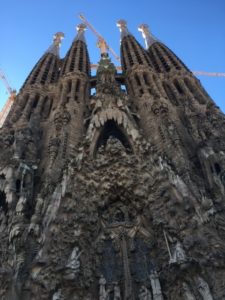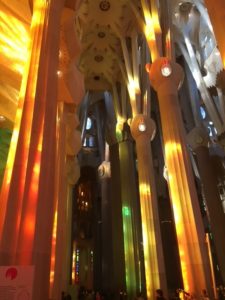I first visited the Sagrada Família in Barcelona in January 2017. I only knew what the structure looked like from the laminated posters plastered onto the walls of classrooms where I had my Spanish lessons in high school. The series of towers clustered around the nave made it seem like half pipe organ, half abandoned factory. It was strange, unlike any church I had ever seen up close. I entered on the northeast side, underneath a façade that looked like it was painstakingly sculpted out of a single piece of sandstone. Shepherds and angels and birds and trees rose above my head, protruding from the rock in a way that reminded me of drip castles you make on the beach when you’re a child. Having grown up around New York, I had seen many impressive buildings, and this one was incredibly striking. Of course, not everyone has been as kind as I was. George Orwell, who coincidentally shares a birthday with the church’s architect Antoni Gaudí, was far more brutal in his commentary. In his Homage to Catalonia, Orwell referred to the Sagrada Família as “one of the most hideous buildings in the world.” He further wrote that the anarchist troops he accompanied “showed bad taste in not blowing it up.”
While the exterior was spectacular, it was not the most impressive feature during my visit to the site. It wasn’t until I passed through the doors beneath the nativity sculptures and entered the structure that I saw its true beauty. Along the nave, a series of columns extended upward. They were fluted as you would see on a classical Doric column from the Parthenon. But they became very different the further upward you looked. They were topped with these large bulbs, which continued and branched off; like stone stems in a massive bouquet, supporting an enormous canopy of flower petals. The columns just went up and up; sort of melting into the ceiling.
It was already incredible, but it was a little overcast that day. I had only been inside for a few minutes before finally, the sun came out. As soon as that happened, the space became flooded with green, red, yellow, and orange light streaming in through the tall windows along the side aisles. Once the colored light filled the church, the structure transformed from one of stone to something made of actual flowers. It was awesome. Quite literally, being very easy to fill one with true awe. I just wanted to stand in the middle of that nave for the rest of the day, hoping the sun would never set.
Saturday, June 25th, marks Antoni Gaudí’s one hundred seventieth birthday, in the one hundred fortieth year of the Sagrada Família’s construction. The construction board has been predicting that the structure will finally be completed by 2026, in time for the one-hundredth anniversary of Gaudí’s death. Even without Covid-related delays, completion by 2026 is a tall order. Despite the likelihood that 2026 the Sagrada Família will probably lack all eighteen planned spires and steeples. I would like to revisit and see the Sagrada Família within my lifetime. I’m still (relatively) young, so it’s not unreasonable. Though still unfinished, standing in the Sagrada Família’s nave is as close to a spiritual experience that even an irreligious person can have. So here’s to Antoni Gaudí. It’s very fitting that such a beautiful edifice can serve as a testament to the beautiful mind of one of Catalonia’s artistic legends.



